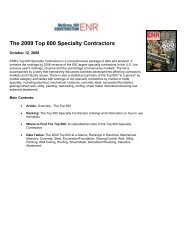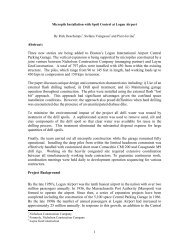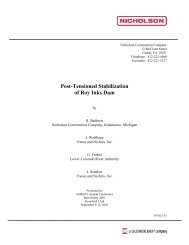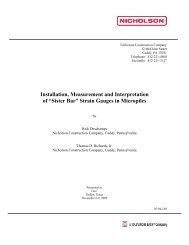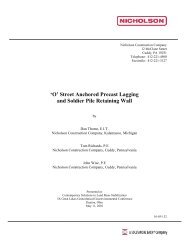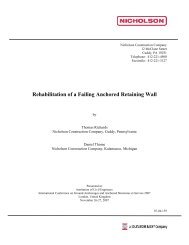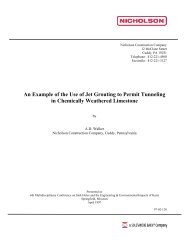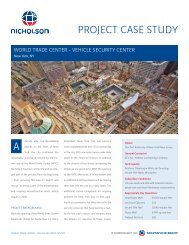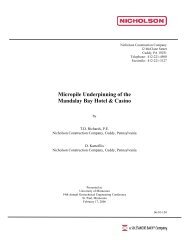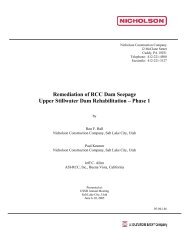recent advances in large diameter diaphragm wall shafts
recent advances in large diameter diaphragm wall shafts
recent advances in large diameter diaphragm wall shafts
- No tags were found...
Create successful ePaper yourself
Turn your PDF publications into a flip-book with our unique Google optimized e-Paper software.
Maximum hoop force is at 23m depth and is equal to 12.5MN.Us<strong>in</strong>g Ha<strong>in</strong> model (2D non-l<strong>in</strong>ear approach), buckl<strong>in</strong>g force is approximately equal to 95EI/R 2 =75MN.Factor of safety on buckl<strong>in</strong>g is <strong>large</strong>r than 6.Inscribed annulus thickness without deviation is equal to 1.158m.Maximum deviation at 23m depth = 10.5cm.Inscribed annulus thickness with +/-10.5cm deviation is equal to 0.948m.Hoop stress at 23m depth without deviations is equal to 10.8MPa.Hoop stress at 23m depth with +/-10.5cm deviations is equal to 13.2MPa.Figure 7. Example Project Information, Excavated Shaft Photo, and Idealized Cross-SectionList of example <strong>large</strong> <strong>diameter</strong> and deep<strong>shafts</strong>A partial list of <strong>recent</strong> <strong>large</strong> <strong>diameter</strong> <strong>shafts</strong>constructed worldwide is summarized <strong>in</strong> Table 1.SummaryThis paper provided an overview of <strong>recent</strong><strong>advances</strong> <strong>in</strong> the design and construction ofcircular <strong>diaphragm</strong> <strong>wall</strong> systems. Thesesystems are especially attractive for the EPAmandated comb<strong>in</strong>ed sewer overflow conta<strong>in</strong>ersbecause they can be constructed to reta<strong>in</strong> <strong>large</strong>fluid volumes without any <strong>in</strong>ternal or externalsupport. Moreover, the systems are costeffective and provide higher certa<strong>in</strong>ty ofexecution dur<strong>in</strong>g construction relative tocompet<strong>in</strong>g systems such as sunken caissons.Additionally, elliptical and circular arc segmentscan also be used to construct efficient systemswith different shapes. The <strong>in</strong>corporation of thearc segments allows for th<strong>in</strong>ner <strong>wall</strong>s, lightersteel re<strong>in</strong>forcement and m<strong>in</strong>imal <strong>in</strong>ternal orexternal support.ReferencesHa<strong>in</strong>, H. H. (1968). Zur Stabilitat ElastischGebetteter Kreisr<strong>in</strong>ge Und Kreiszyl<strong>in</strong>derschalen,University of Hannover, Mitteilung Nr. 12.Timoshenko, S. and Gere, J. (1961) Theory ofElastic Stability, McGraw Hill, New York, 2 ndEdition.



